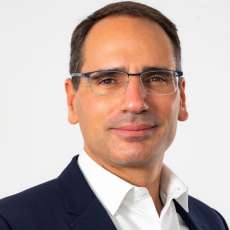In the larger picture of the biotech industry, where does Ichnos fit?
Ichnos was launched in 2019 as a spin-off from the innovation unit at Glenmark - a large generic pharma company in India. We emerged as a global clinical-stage biotech company with the purpose of developing innovative multispecific therapies in oncology that extend and improve lives. Our pipeline is comprised of seven assets: five in oncology and two in autoimmune diseases. The oncology assets are based on our proprietary platform called BEAT® (Bispecific Engagement by Antibodies based on the TCR). We are nimble and have a fairly small team of 200 professionals, and we aim to achieve important milestones in the years to come.
What does BEAT® consist of and how is it different compared to other platforms on the market?

BEAT® is a protein platform designed to enable more efficient production of multispecific antibodies that can engage multiple targets on the tumor and on immune cells simultaneously in order to enhance the power of the immune system to fight cancer.
The platform is highly flexible and contains heavy chain heterodimerization technology as well as universal light chains that simplify the production of multispecific antibodies. Combined with mutated Protein A, a high-yield purification of over 95% and limitless targeting potential, which might allow our candidates to address a wider range of diseases.
You have a diverse pipeline comprised of multiple candidates. In broad lines, which possible therapies have proved to be the most promising?
In the space of oncology, we are especially excited about ISB 2001 which is a trispecific antibody for the treatment of relapsed/refractory multiple myeloma. In May of this year, we may be dosing our first patient with this therapy pending health authority clearance, and we are eager to gather data about its clinical efficacy since its preclinical results showed higher tumor cell-killing potency compared to approved treatment options. Last year we initiated the first-in-human clinical trial for ISB 1442 in relapsed/refractory multiple myeloma, for which we have a particularly fast dose escalation based on the innovative study design. Based on these results, we plan to start a Phase 1 trial with ISB 1442 for acute myeloid leukemia later this year.
ISB 880(ALM27134) is a monospecific monoclonal antibody that targets IL-1RAP and has the potential to treat patients with a variety of autoimmune dermatologic diseases. We out licensed it to Almirall in December 2021 and they announced the start of a Phase 1 study in September 2022. Our second inflammation and immunity asset is telazorlimab (ISB 830), an anti-OX40 monospecific monoclonal antibody that we developed up to Phase 2b. This asset has the largest safety database so far in this category, and it targets the T cells that are involved in relapsed atopic dermatitis. Compared to its competitors, it does not have a depleting function, so it does not induce long-term infection side effects. It binds to the OX40-expression immune cells and not the OX40-ligand, therefore it does not damage normal cells like smooth muscle or respiratory airway cells. Moreover, it could have the ability to address higher unmet medical needs like seropositive autoimmune diseases (e.g., rheumatoid arthritis, systemic lupus erythematosus) although the clinical experiments are still pending. A good safety profile is vital because atopic dermatitis is a debilitating, but benign condition in a rather young population, for which we aim at providing the least toxic therapy.
With all the advancements happening today, is there a chance that cancer could become a potentially chronic disease?
Metastatic breast cancer and prostate cancer are indications that can already be considered chronic diseases. A cure of multiple myeloma is made difficult since the cancer cells hide from the immune system in the bone marrow and may induce a relapse. Although gene and cell therapies are producing amazing results, the treated population remains fairly low overall and manufacturing timelines can be challenging to match a progressive disease, including the rarity of raw materials like antiretroviral vectors. With the help of multispecifics, we are hoping to achieve the same efficacy and durability of remission as gene and cell therapies, but with the benefit of having therapies readily available for a bigger number of patients.
How are you navigating the actual financial environment, which has proved to be quite challenging for biotech companies?
Fortunately, we have the privilege of being a privately owned company but it is our social responsibility to make sure that we are spending our money wisely. The long-term plan is to become financially independent but for now, we are better off developing our assets under the private umbrella which avoids any distraction, while preparing a clinical efficacy package that will hopefully attract pharmaceutical partners and investors. We are actively seeking partnerships in oncology as an opportunity to externally validate our innovation, create further revenues and possibly go public.
What are the main objectives that you would like to achieve in the coming few years?
In the coming years, we plan to establish proof of concept for our proprietary BEAT® platform while also improving it with new features. Our research team is focused on developing additional assets in solid tumors leveraging Ichnos’ NK cell engaging platform. We will also remain focused on advancing ISB 2001 to a first-in-human clinical study and selecting the first clinical candidate for ISB 2004. Ultimately, in 12 to 18 months' time, we aim to become a financially independent company.





